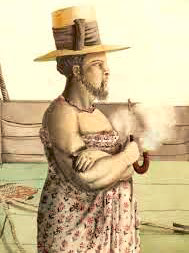Episode 5 (of six) of the Saga of the North Shore
By Captain Richard W. Rogers
In about 1773, the Ali`i of Oahu elected to choose a young chief of nobel birth to rule as “Moi” over their island. Kahahana, son of the Ewa chief Elani, of the Maweke line, had been raised in the court of the Maui warlord Kahekili.
Kahekili requested the sacred lands of Kualoa and all the whale ivory on Oahu as payment for raising Kahahana. The request was denied, primarily due to the interference of the high priest from Waialua, Kaopulupolu. Kahekili spread false rumors of Kaopulupulu’s disloyalty, which bore fruit in the execution of the priest for high treason. With the high priest out of the way, Kahekili went to war against his nephew and conquered Oahu. Kahahana managed to hide in the mountains for two years before he was, in turn, executed and sacrificed, on Kahekili’s order.
In late 1785, Elani attempted revenge for his son’s death by fomenting a rebellion amongst the Oahu chiefs, who were to kill all of the Maui chiefs on a certain night. The plan was discovered and only in Waialua did any Maui chiefs get killed that night. Kahekili’s revenge was awesome. Every single chief of Oahu and all of their families, along with thousands of their followers, were slaughtered. The Maweke line was exterminated and the bones of those chiefs were made into a huge house, which stood for many years in Moanalua. Elani’s body was placed on the coral platform just off Haleiwa Beach Park, which is named “Kahakau Kanaka”. Kahekili used Oahu as a source of supplies for his wars on the windward islands.
Kahekili died in 1793, leaving Oahu to his son Kalanikupuli. The Army of Kauai was returning from the wars to the east and made war upon Oahu. Many warriors from Waialua and Waianae joined the Kauaians. By this time firearms, small and heavy, were being used to deadly effect by all combatants. Every Hawaiian high chief had Europeans in their ranks to train their infantry and direct fire from their cannon. The Kauai forces were defeated on the Ewa Plains.
Within a few months Kamehameha’s army swept across Maui, and Molokai to land at Waikiki. In the “Battle of Nu`uanu” the forces loyal to Kalanikupuli were pushed up the valley where many warriors and their followers perished, as they were backed up and over the Pali.
Kamehameha garrisoned his Army on Oahu in preparation for an attack on Kauai. When news that the Kauai invasion had failed reached the Big Island, there was a rebellion which demanded Kamehameha’s attention. Upon leaving Oahu, Kamehameha had all the taro dug up and all of the pigs on Oahu slaughtered. His reasoning was that so long as the people were concerned about famine, they would not have the energy to revolt against his rule.
With no high chiefs or warriors to support, the bounty of Oahu returned. Eight years later, in 1804, Kamehameha returned with his army. This time, more attention paid to agriculture. Kamehameha needed trading material, so as to purchase yet more firearms as well as floating stock. Kamehameha had become a ship owner and was entrenched in the sandalwood trade, which dealt in that and Pacific Northwest sea-otter pelts being sold to the Chinese, in trade for black tea.
When Kamehameha died in 1819, his closest familymembers maintained tight control of the islands. Keeaumoku Cox was given control of the Waialua District, which he used exclusively to extract products of the land and sandalwood from the mountains. By 1830 Cox had passed away, the sea-otters were nearly extinct and the sandalwood was gone. Waialua was given to one of Kamehameha’s daughters. Pi`ia. She and her husband La`anui settled on the North Shore and were instrumental in advancing the cause of Christianity.
With the Great Mahele of the 1840s, a more western-style of land ownership evolved. A granddaughter of Kahehameha named Kamamalu was granted much of the Waialua District. When she passed away in 1866, her lands were inherited by the last of the Kamehameha line, Pauahi Bishop. All of her lands have been retained in trust, to be used for the “Education of the Children of Hawaii”.
Next month, we will discuss the early Haoles and how they interacted with the residents of the North Shore.



